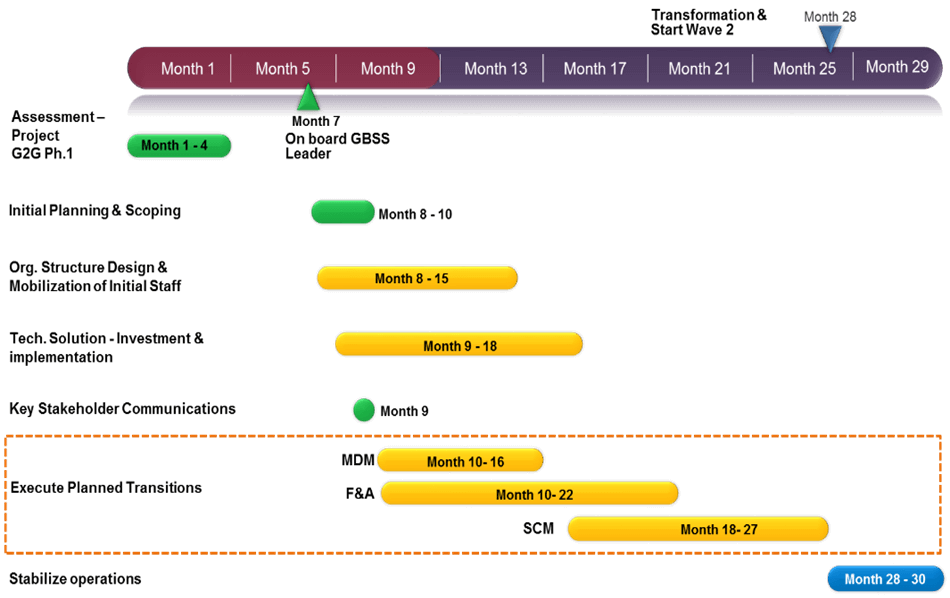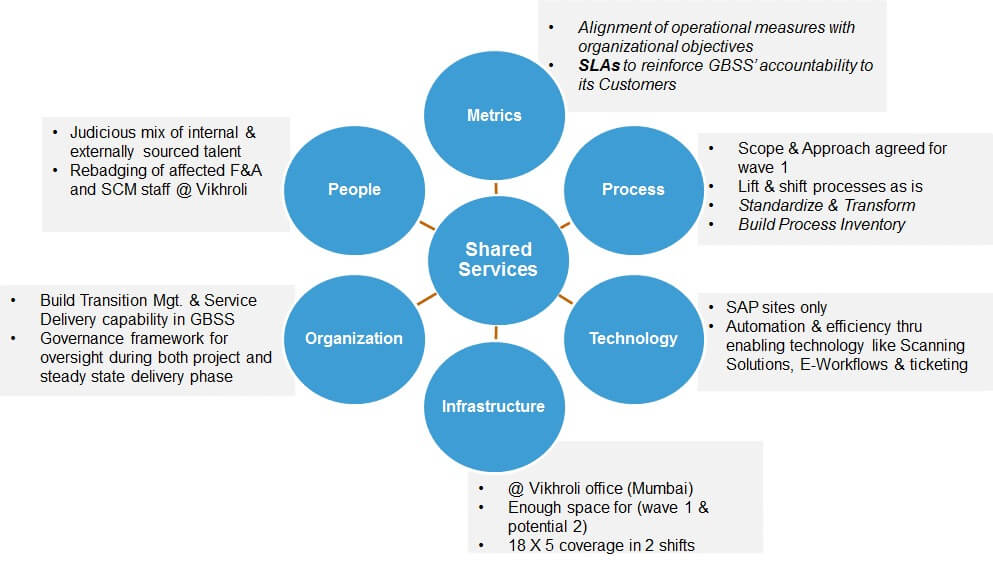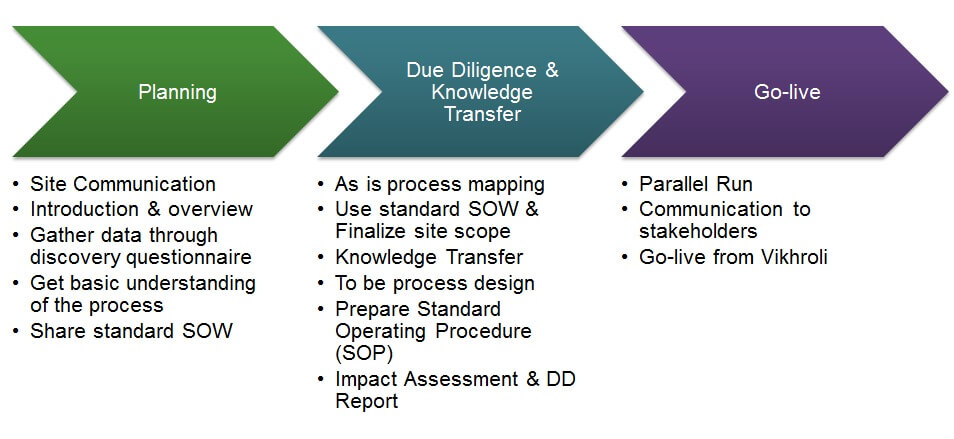Post sale of its domestic formulations business to Abbott, the senior leadership of Piramal Enterprises (PEL) deliberated upon the company’s vision & focus areas for future growth. Specifically within the Pharma/ Healthcare business, several initiatives were taken under Project ‘Good to Great’ (Project G2G) to revitalize the business.
Project G2G, which started in last quarter of 2013, was aimed at understanding how the business support functions can effectively support PEL’s future growth plans.
The Project G2G was thus focussed on dramatically improving the functioning of the company’s internal service functions like Finance, Supply Chain and Human Resources with a view to create a scalable structure that would support the company’s growth ambitions in the Pharma/ Healthcare space.
It was felt that ‘low hanging fruits’ (processes where there would be least resistance to consolidation) could be considered for transition first, as this would help create credibility & acceptability for Shared Services model.
As a first step, an external consulting firm was engaged to benchmark PELs internal service functions vs. its peer group and world class organizations from an efficiency and effectiveness standpoint.
The findings from the study (both quantitative & qualitative) revealed significant opportunities to create an effective services organization, especially the following:
- Need to develop a more process-centric service operation with world-class effectiveness and efficiency levels
- Requirement to drive alignment across functions to improve operation of end-to-end processes
- Opportunity to drive standardization of processes across business units/ sites
- Opportunity for enhanced use of automation and SAP to enable process effectiveness
The senior leadership team deliberated over these findings and by end of first quarter of 2014, decided on the following outcomes:
- Restructure the Supply Chain Organization & transform it from a procurement organization to a planning led organization with a strong centre led Procurement team
- Roll-out a Global Shared Services model for transactional process consolidation. This new Shared Services organization would be accountable for service delivery based on defined measures (KPIs, cost, quality etc.).
Shared Services Strategy Execution
- Planning:
The key considerations in the planning for execution involved Phasing of Transitions, Scoping, Transition Methodology & (site-wise) Sequencing and the Operating model.
Deployment of a Global Shared Services model was PEL’s first major BPM initiative.
The organization was going through a big change driven by strategies like Supply Chain, HR and Quality transformation and Shared services implementation.
Hence, it was felt by the leadership team that given the variations in the business operating models, processes etc. at each site/ geography and keeping in view the people impact, it would be appropriate to adopt a phased approach vs. a big bang approach.
It was felt that ‘low hanging fruits’ (processes where there would be least resistance to consolidation) could be considered for transition first, as this would help create credibility and acceptability for the Shared Services model.
Working Capital Management was one such area that offered significant scope for improvement. Since process ownership, in this area, especially in the Order-to-Cash cycle, was either diffused or not clearly defined, it was felt that the first wave of transitions should be focussed on processes underlying Working Capital Management.
Wave 1 Scope Evolved After Several Deliberations With The Functional Stakeholders

- This was followed by separate set of discussions with the Business and Site heads to share with them the scope and seek their buy-in for the scope and high level transition plan.
The Transition roadmap envisaged an 18 month period (Oct ’14 – Mar ’16) for completion of Wave 1 (scope) transitions.
Snapshot Of The Transition Plan

- Another important outcome of the planning process that emerged after several discussions with the stakeholders and high level understanding of the business processes was the design of Shared Services operating model, which was shared with Business and Site heads before the company started the transition of processes into Shared Services.
The PEL Global Business Shared Services (GBSS) Operating Model Design

To ensure smooth transition, we deployed a well-defined implementation methodology that included amongst other elements finalization of the Statement of Work with Senior Functional stakeholders, understanding of the existing processes, business/ location specific challenges ‥‥
- As can be seen from the operating model above, the company’s resourcing/ staffing assumed a healthy mix of existing employees (rebadged from other departments) and new external hires (with domain specific expertise to be hired from BPO or Shared Services space).
To ensure adequate staffing before the start of transitions, the company started the process of identifying internal resources and hiring external resources simultaneously along with stakeholder buy-in for scope, transition roadmap and operating model design.
- Execution of Transition Plan:
The execution process started with the hiring of the head of shared services in July ‘14. The original process wise/ site wise transition plan as agreed with senior stakeholders envisaged consolidation of processes pertaining to domestic sites first, from a sequencing stand point, so that learning from these migrations can be leveraged for a more effective transition from our overseas sites. To ensure a smooth transition, the company deployed a well-defined implementation methodology that included amongst other elements finalization of the Statement of Work with senior functional stakeholders, understanding of the existing processes, business/ location specific challenges and requirements etc.
Transition Methodology Adopted For Each Site (For Each Process Transition):

The company used series of interventions during the Due Diligence and Knowledge Transfer stages of the transition to educate & encourage the site teams (“customers”) to transition from old state to new state. The process of (internal) customer education began typically with the kick-off meeting for any process transition which clearly laid out what to expect during due diligence and knowledge transfer. The impact assessment sessions and the close out meetings post completion of due diligence and knowledge helped clarify to the stakeholders and the impacted functional team what to expect after a process transition.
PEL’s Shared Services journey…has had all the essential ingredients for success like strong Senior Leadership commitment, Effective Change management driven by Project G2G, thorough upfront planning, compelling Business case, agile Project management, comprehensive communication with employees and very effective knowledge transfer.
Despite several challenges and some changes to the original transition plan triggered by business needs and exigencies, the Wave 1 process transitions was successfully completed by end of April’16.
A robust communications strategy helped ensure a smooth transition despite various challenges and process complexities.
The company followed a multi-pronged communication strategy to ensure clear & consistent messaging relative to the deployment of Shared Services Operating model and transition of Wave 1 processes.
The communication strategy involved:
- Various updates to the site leadership team during a process transition
- Weekly updates to the Steering Committee, Site Leaders and Site Functional Leaders (high level view on progress made, action plan for next week, challenges and issues and areas where support was needed)
- Quarterly updates during the Global Leadership team meetings
- On top of the above, the company also had weekly meetings with the sites for addressing operational issues during the monthly operations review meetings, post process transition
The Journey So Far‥‥
“And, when you want something, the entire universe conspires in helping you to achieve it.”
This phrase from Paulo Coelho’s best seller ‘The Alchemist’ aptly describes PEL’s successful execution of the Shared Services strategy and its journey so far, which has had all the essential ingredients for success like strong senior leadership commitment, effective Change Management driven by Project G2G, thorough Upfront Planning, compelling Business Case, agile Project Management, comprehensive Communication Plan and very effective Knowledge Transfer.
The execution phase of Shared Services journey within PEL started in Oct ’14 and today the Global Business Shared Services team is a 85 member organization serving the Pharmaceuticals, Critical Care and OTC businesses within the Healthcare umbrella (overall Business revenue upwards of US $ 500 Mn) spread over 18 locations globally.
Service delivery for the processes transitioned as part of Wave 1 has not merely stabilized but has also started adding value to business through:
- Operational metrics i.e. TAT and accuracy levels that are shared as part of our monthly operations review meetings with the site leadership teams
- Improvement in Business Metrics, e.g.
- )7 day DSO improvement over 5 quarters since transition of AR process for our Pharma Solutions business
- )Steady improvement in percentage of vendor invoices paid on time (POT)
- Optimized Processes, strengthened Internal Controls and tighter policy compliance
- Process enablement leveraging automation – Readsoft (scanning, OCR & workflow) for better managing Payables, Receivables and Sales Order processes
- Continuous Process Improvements projects/initiatives identified based on feedback through formal Customer Satisfaction surveys & Governance process
The Shared Services journey so far and the outcomes of a successful Wave 1 transition have given confidence to the senior leadership within PEL and the company is now contemplating the next wave of process transitions.
ABOUT THE AUTHOR

Narendrra V Arora has over 22 years of experience in various areas of Finance & Accounting spanning diverse industries in multi-cultural settings, and managing Shared Services operations of which ~9 years have been in Country CFO/Controller roles.
He has led numerous initiatives to improve operations, impact business growth & maximize profits through achievements in finance management, cost reductions & internal control. Narendrra has also led several productivity improvement initiatives through best practices benchmarking, waste elimination and continuous process improvements thereby favorably impacting bottom-lines. He is a qualified CA, CS, ACCA and CWA and has earlier worked with companies like Johnson & Johnson, Thermo Fisher Scientific, Owens Corning, Publicis Groupe & OCS Group. He is currently Vice President, Global Business Shared Services at Piramal Enterprises Limited.



 Ask an Expert
Ask an Expert



